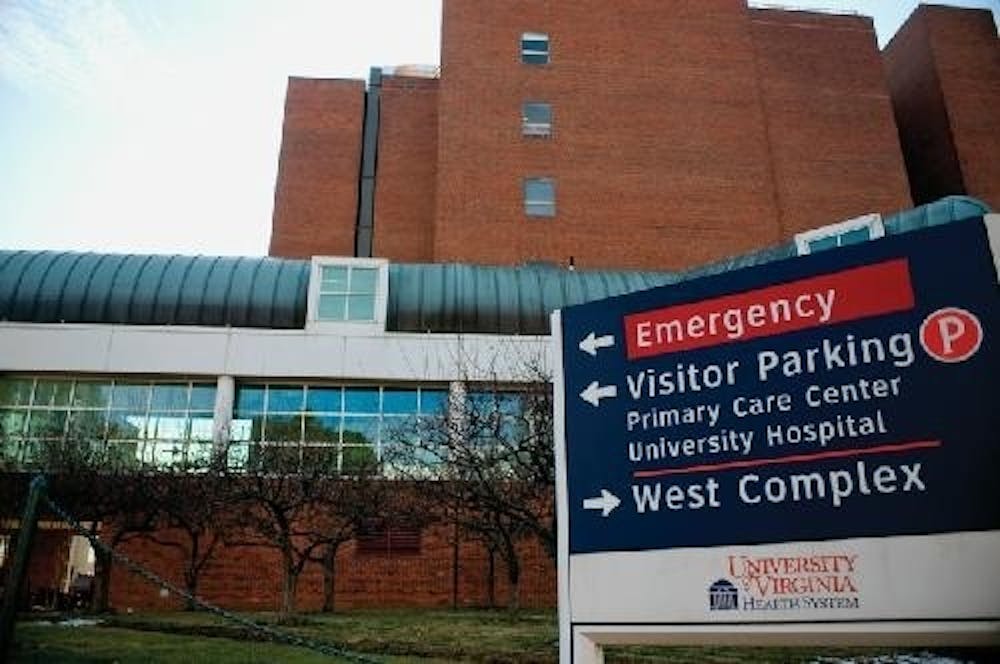University President Teresa Sullivan named Dr. Richard Shannon the Executive Vice-President for Health Affairs earlier this month. Shannon will begin officially as EVP on November 1, though he will begin commuting to Charlottesville on September 1.
Shannon, who currently chairs the Department of Medicine in the University of Pennsylvania Health System, will oversee the University Medical Center, the U.Va. Physicians Group, clinical operations of the Medical School and Nursing School and the Claude Moore Health Library.
A search committee, co-chaired by Executive Vice Presidents John Simon and Pat Hogan, began reaching out to candidates as early as March and April of this year, Shannon said. The search committee included faculty and staff from across the Medical Center, who were joined by participants from the Nursing School and a member of the Board of Visitors.
A cardiologist by training, Shannon intends to focus on increasing healthcare quality and patient safety throughout the Medical Center. He said the University has made strides toward providing better quality care and reducing unnecessary medical errors, but it still needs a great deal of improvement.
“My goal will be to make it such that everybody…will be committed to the notion that, a, no one gets hurt and, b, we will be habitually excellent,” Shannon said. “I think there is a fertile ground for becoming the best at this.”
No room for error
Shannon said he hopes to build a culture of safety and quality care through a lean business model, where caregivers are empowered to fix problems while they are helping patients, instead of waiting for retrospective reviews. The lean model was made famous at Toyota car manufacturing plants.
“I like the lean thinking approach, where workers are given eyes to see and solve problems at the point of care,” Shannon said. He hoped “that people learn to view problems as the next opportunity to learn and build new knowledge.”
Shannon gained notoriety for being one of the first chairs of a major medical system’s academic department to focus on hospital-acquired infections while at the University of Pennsylvania Medical System.
“I don’t think an organization, particularly a healthcare organization, can aspire to be great if patients are inadvertently harmed when we deliver care,” Shannon said. “[Errors] are unambiguous examples of waste that add no value to the healthcare system.”
During his time as Chair of the Department of Medicine at Allegheny General Hospital in Pittsburgh, PA, Shannon focused on diminishing the number of bacterial infections acquired in hospitals. These infections result in longer hospital stays and patient deaths.
“I became extremely interested in safety as a prerequisite for quality and excellence in healthcare,” Shannon said. “We have [also] done the business case around eliminating errors, and demonstrated that it is a great way to get rid of financial waste.”
While at Allegheny General, Shannon published research showing hospitals lost more than $25,000 per patient when patients acquired a specific type of blood infection. Shannon showed that increased payments from health insurance companies did not offset the high cost of dealing with those infections for hospitals.
In an interview with the federal Agency for Healthcare Research and Quality, Shannon said Penn had seen substantial decreases in hospital-acquired infections under his watch by increasing the number of medical support staff on duty and asking those additional employees to specifically monitor common infection issues.
In the AHRQ interview, Shannon said patients who contracted central blood line infections were staying 17 additional days in the hospital and had a 22 percent mortality rate, lending an impetus to reform.
Shannon said he supports transparency in medical data as a way to drive improvement.
“I think that transparency is a prerequisite for organizational excellence,” Shannon said. “I believe that public reporting serves the principled purpose of driving improvement, but organizations need leaders who will take up the challenge of recognizing where they are.”
Shannon currently sits on the technical advisory panel of the Pennsylvania Healthcare Cost Containment Council, which collects safety data from hospitals statewide. After 12 years of work, he said he will likely have to resign his appointment.
Measure twice
Penn, however, has come under scrutiny from patient safety organizations during the time Shannon has led safety efforts there.
The Leapfrog Group, a health insurance purchaser-funded nonprofit focusing on hospital safety, gave the Hospital of the University of Pennsylvania below a C in its first round of hospital safety scores. While that hospital improved to an A in the next round of grades, Pennsylvania Hospital, which is also part of the Penn Health System, received a C. Leapfrog graded hospitals on a standard letter grading scale based on a series of publically-reported safety measures.
The Hospital of the University of Pennsylvania had worse than average rates of “serious complications” and urinary tract infections from catheters, according to data released by Medicare. The hospital scored equal to the national average in most categories.
Shannon said the Leapfrog Group’s methodology was not yet at the point where lay people could effectively use the information. Instead, Shannon said public reporting was a useful way for internal leaders to promote quality improvement.
“I think public reporting for the purposes of grading is probably premature,” Shannon said. “So public reporting should be to allow each organization to get better.”
Shannon added that the culture of safety he built at Penn’s Department of Medicine did not permeate the rest of Penn’s Medical System.
“Penn is a great example, like many academic medical centers, where there are islands of excellence, but there isn’t habitual excellence across the organization,” Shannon said. “That’s why organizational leaders are so vital to continuous improvement.”
The University Medical Center received a D in the Spring 2013 Leapfrog grading, despite receiving credit for above-average performance in most categories of the Leapfrog Hospital Survey, which Penn did not complete.
The Medical Center was worse than the national average in falls and trauma, pressure ulcers, and death from serious treatable complications after surgery. Nearby Martha Jefferson Hospital received a B grade, despite not completing the Leapfrog survey.
Eliminating waste, Shannon emphasized, was a way to not only improve quality of care, but also to increase profits.
“It is a great example of an opportunity to transform healthcare without rationing and without price reduction that I think right now are very difficult issues as we contemplate healthcare reform,” Shannon said.
New methods for an old mission
The University Medical Center has had difficulty providing care to poorer and older populations covered by government-funded health insurance. According to the Medical Center’s 2013-2014 budget, government funding has not kept pace with rising medical costs.
“The Medical Center has seen growth in volumes over the last year, but a disproportionate share of the growth has been Medicaid and Medicare patients,” the budget report stated. “One of the Medical Center’s largest challenges is the unwillingness of government payors to increase their payments commensurate with the increases in medical delivery costs.”
The Medical Center projected $72.4 million in operating revenue, or effective profit, for the 2013-2014 year. The Medical Center’s 2012-2013 original budget assumed $74.8 million in operating revenue, while the actual 2012-2013 total is now projected to be close to $100 million. The Medical Center receives revenue from patients, its endowment and research grants, often from the federal government.
Shannon said he sees caring for needy patients, including those covered by Medicaid – a joint state and federal program for those near or below the federal poverty line – and the uninsured as a central part of the Medical Center’s mission.
“I believe it is our duty to care for the less fortunate and particularly those whose economic circumstances require that they have Medicaid for their insurance,” Shannon said, “and we will never shrink from that duty.”
Shannon said eliminating waste in the medical system, stemming from unnecessary medical errors and poor quality of care would help the Medical Center’s bottom line.
Shannon also said the University’s Health System needs to increase its footprint. The Medical Center, Shannon said, can continue to treat the less fortunate and invest in academic research by partnering with other local healthcare providers to care for the broader community.
“An essential part of reform will be to think broadly about not just the people in the hospital beds, but broadly about people in the community,” Shannon said.
Population healthcare asks health systems to cooperate with nearby doctors in order to reduce emergency room visits, hospital stays and other unnecessary medical care. One model Shannon said the Medical Center should consider is engaging in risk sharing.
In risk sharing models, health systems are paid a flat fee to manage all of the healthcare for each patient. If patients spend less time in the hospital and emergency room, the health system makes money. Under traditional fee-for-service healthcare, hospitals profit from more emergency room visits.
Penn and Independence Blue Cross, an insurer in Philadelphia, announced a renewed partnership in January of this year to tie payment of medical insurance claims to Penn’s ability to reduce overall costs for consumers.
Taking the driver’s seat
While the University’s Medical Center has encountered problems with cash flow, it is still vital to bringing jobs and revenue into Charlottesville and Albemarle County.
In fiscal year 2012, the most recent statistics available, the Medical Center admitted 28,695 patients and saw 61,596 patients in the emergency room. The Medical Center is projected to employ 7,198 full-time equivalent positions in the 2013-2014 year, which does not include staff at the medical and nursing schools whom Shannon will oversee.
Revenue from patients, which accounted for 42.4 percent of total revenues for the entire University of Virginia in 2012-2013, is projected to account for 45.1 percent of total revenues for the University in the 2013-2014 fiscal year. The Medical Center is expected to have a $1.2 billion budget in 2013-2014, a projected 8.7 percent increase over the previous year.
Shannon currently oversees 250 standing faculty, 150 residents and over 800 employees along with $104.9 million in grant support as head of Penn’s Department of Medicine.
Sullivan said she is confident Shannon, who will report along with Simon and Hogan directly to the President, can lead the University’s growing health system.
“He is nationally recognized for patient-care innovation, research, educational and clinical experience,” Sullivan said in a press release. “The University will benefit greatly from a leader like Dr. Shannon, who has a strong management track record within a complex, academic health center.”
Shannon said he will resign several posts he holds in Philadelphia to take his new job at the University. However, he intends to remain on the Board of Directors of American Board of Internal Medicine, which certifies most non-surgeon medical doctors in the United States, and remain a Senior Fellow at the Institute for Healthcare Improvement.





